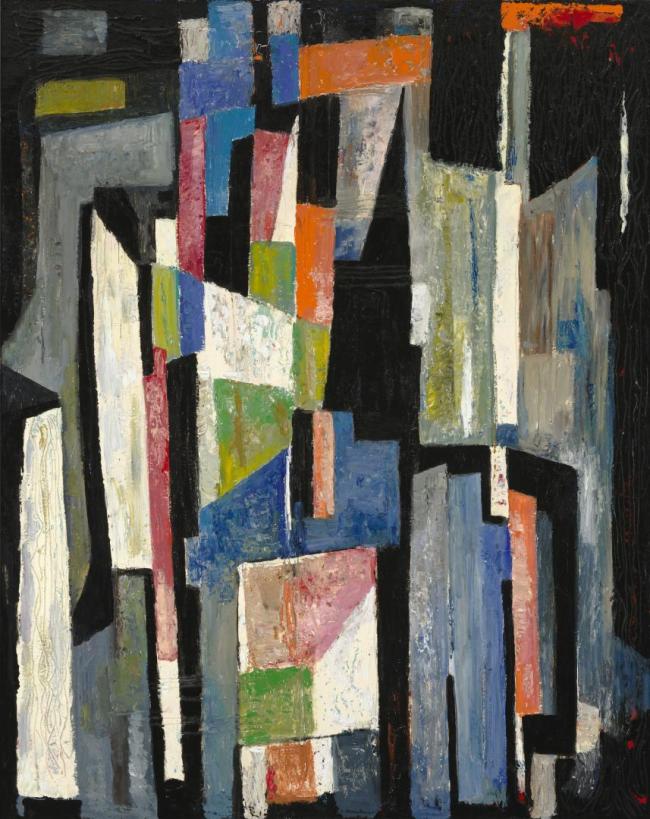CURATOR: ESTHER TRÉPANIER
Opening: June 20th, from 5 p.m to 8 p.m
Four artists who are today relatively or almost entirely unknown – one woman and three men – played a part in the aesthetic upheavals that led in 1940s Montreal toward abstraction. Very active in the art milieu throughout the decade, Marian Dale Scott, Fritz Brandtner, Henry Eveleigh and Gordon Webber captured the attention of critics of the time, who employed the term “abstract art” to describe both non-objective works and bold formal explorations that retained some reference to visible reality.
These artists’ works reflected their openness to international contemporary art trends of the period – French, German, British and American. However, the stylistic unity displayed by the Automatistes, led by Paul-Émile Borduas, furthered the ascendancy of this group’s view of abstraction as a kind of unplanned visual writing arising from the spontaneous impulse of an initial gesture. Combined with the revolutionary tone of their 1948 manifesto Refus global, this established the Automatistes as Quebec’s abstract avant-garde, with the result that other approaches to abstraction being pursued at the time were relegated to the background.
The aim of this exhibition is to reinstate the oeuvres of these forgotten protagonists in the narrative of abstract art and to illustrate how their practices were inspired by diverse sources and encompassed a variety of themes: emotion, science, human experience in the broadest sense, but also the violence that marked their era.
Fritz (Friedrich Wilhelm) Brandtner (Danzig 1896-Montreal 1969)
Born in Germany, Fritz Friedrich Wilhem Brandtner enlisted at the age of 18 and took part in combat before being held prisoner in France. Liberated in March 1920, he returned to Danzig where he acquired a mostly self-taught education in art and art history. He immigrated to Canada in 1928, and in 1934, settled in Montreal where he became part of the local scene of modern artists.
Convinced that art could enrich the lives of the less fortunate, Brandtner began teaching children’s art classes at various centres in disadvantaged neighbourhoods during the 1940s. From 1944 to 1966, he earned a living as a teacher at Miss Edgar’s and Miss Cramp’s School, and at McGill University’s School of Social Work, where he taught from 1947 to 1956, initiating future social workers to his progressive vision of art.
Henry Rowland Eveleigh (Shanghai 1909 – Montreal 1999)
Henry Eveleigh, born in Shanghai of British origin, studied art at London’s Slade School of Art in 1934. After several trips throughout Europe and Shanghai, he immigrated to Canada in 1938.Trained in advertising art, Eveleigh began working in that field in 1930. During the war, he created propaganda posters for the information services of the Wartime Information Board. In 1947, he won First Prize in the United Nations’ (UN) first international poster contest, which prompted the director of the École des beaux-arts de Montréal to hire him to establish the school’s graphic design department. At the same time, Eveleigh founded an advertising and commercial design business with fellow graphic designer Carl Dair. He also went on to become one of the first directors of the Université de Montréal’s graphic design department where he taught until his retirement, after which he was finally able to resume painting.
Marian Mildred Dale Scott (Montreal 1906-Montreal 1993)
From a young age, between 1917 and 1920, Marian Mildred Dale Scott acquired her first formal art training at the Art Association of Montreal School. She was then among the first women to enroll in the École des beaux-arts de Montréal, where she studied from 1923 to 1926, before going on to complete her training the following year at the Slade School of Art in London, England.
Despite her status as a mother and as the wife of the eminent lawyer, poet, and member of Canada’s left-leaning social democratic movement, Francis Reginald (Frank) Scott, Marian Dale Scott pursued her art practice until the end of her life. In 1939, she became a founding member of the Contemporary Arts Society and regularly exhibited with them. For over seventy years, she presented her work in the annual exhibitions of the Art Association of Montreal, the Royal Canadian Academy of Arts, the Canadian Group of Painters, and participated in numerous group shows throughout Canada and internationally. Scott also produced two public art murals.
Gordon McKinley Webber (Sault-Sainte-Marie, Ontario, 1909- Montreal, 1965)
Gordon Webber first studied art at the Ontario College of Art from 1924 to 1927, and at the Art Students League of Toronto from 1928 to 1930. Over the course of the 1930s, he exhibited and taught, namely at the Children’s Art Centre, founded by Arthur Lismer. He also taught at the Art Association of Montreal School from 1943 to 1954.
A signatory of Alfred Pellan’s 1948 group manifesto Prisme d’yeux, Webber took part in two of the group’s exhibitions. Throughout his career, he participated in a large number of solo and group exhibitions, and created many murals and public art works as part of architectural projects.
ABOUT THE CURATOR
Esther Trépanier
Professor emeritus from the department of art history at the Université du Québec à Montréal, where she taught from 1981 to 2020, Trépanier (1951-2024) was also the director of the Musée national des beaux-arts du Québec from 2008 to 2011, and director of the École supérieure de mode de Montréal from 2000 to 2007. She is the author of several books, exhibition catalogues, and articles on Quebec and Canadian art from the early 20th century and on issues relating to modernity. Among these titles are Peinture et modernité au Québec, 1919–1939 (Nota bene, 1998), and Jewish Painters of Montreal: Witnesses of their Time, 1930–1948 (Les Éditions de l’Homme, 2008). She has also worked as a curator or collaborator on a number of exhibitions, including Marian Dale Scott: Pioneer of Modern Art (MNBAQ, 2000), Femmes artistes. La conquête d’un espace : 1900–1965 (MNBAQ, 2009; MAJ, 2010), and Mode et apparence dans la peinture québécoise, 1880–1945 (MNBAQ, 2012).
This exhibition is produced and circulated by the Musée d’art de Joliette with the financial support of the Government of Canada and the City of Joliette.


![]()
Locally sponsered by

Top artwork credit: Gordon McKinley Webber, Design No. 1, Vermont, 1946, tempera and ink on board, 50.8 x 73.6 cm. Gordon Webber Fund. John Bland Canadian Architecture Collection, McGill Library. Photo: Digital Initiatives, McGill Library


